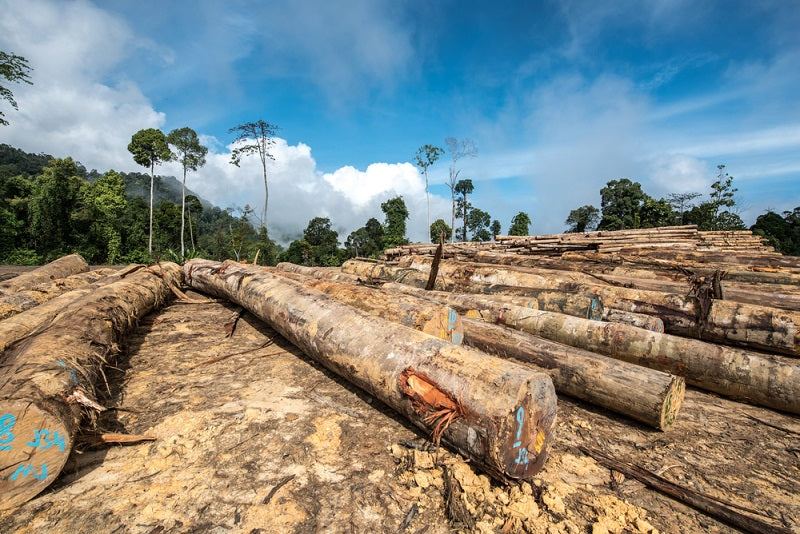
TLDR
It’s been fifteen years since former Vice President Al Gore shined a spotlight on environmental damage with his Oscar-winning documentary An Inconvenient Truth. As tropical forests continue to disappear, that same siren call to address climate change and deforestation is louder today than ever before.
It should be no surprise to you that the earth is spiking in temperature, ice caps are melting, oceans are rising, and forested areas are still being razed at alarming rates. But how does deforestation affect the environment and what role does it play in climate change?
Today, we’re illuminating the profound impacts of deforestation and the importance of forest cover in our holistic ecosystem. A brighter, greener future begins first with an education. So let’s start.
What Is Deforestation?
Before diving into the effects of deforestation, it’s paramount that you understand exactly what the initiative entails.
Deforestation is the mass clearing of forested land to make way for other uses. Typically driven by human design, deforestation can also be caused by natural events like floods or forest fires. For an area to be deforested, all trees need to be removed.
If the forest has fewer trees but is not entirely omitted, then it’s forest degradation. When a forest is degraded, some of the natural infrastructure remains but the biological makeup has been reduced to the point that the area can no longer function as a complete ecosystem.
What Causes Deforestation?
There are a number of reasons certain regions or developing countries will deforest a specific area. They include but are not limited to:
- Agriculture (both for crops and livestock)
- Logging, mining, and other resource extraction
- Urbanization and infrastructure expansion
Oftentimes, one “need set” begets another, like abandoned logging roads creating an opportunity for individuals to illegally raze the land for subsistence agriculture.
Additionally, consumerism is a primary driver of the deforestation of tropical forests. For instance, human demand for single-use paper products is one of the worst offenders and it’s estimated that every day, there are almost 27,000 fewer trees just to make toilet paper.1
At its core, deforested areas are caused by human expansion and a demand for both natural resources and products.

How Deforestation Affects The Environment
While it’s obvious that deforestation annihilates healthy forests, the practice affects far more than just the trees. The ripple effects can be felt across various other facets—the changing climate, human health, and ecosystem biodiversity.
#1 Climate Change
Climate change continues to take the microphone on our global stage. Today, it’s impossible to ignore. Caused by an excess of carbon dioxide in the atmosphere that contributes to the greenhouse effect of rising global temperatures, deforestation is considered one of the direct causes of climate change.
Thankfully, certain countries and their leaders are beginning to take action. In one recent example, the United Nations’ climate summit (COP26) resulted in a pledge to end tropical deforestation by 2030 that was signed by over 100 world leaders, and designated a fund of over 1 billion dollars aimed at preserving the Congo Basin, which is the second largest tropical rainforest on Earth.2
#2 Human Health
Just because a large portion of the world’s population doesn’t live directly within—or around—forested areas doesn't mean they’re immune from the effects of deforestation.
Unfortunately, deforestation has impacts experienced in disease control, air quality, food scarcity, and human displacement.
Disease
Trees and plants have been used medicinally—for centuries—to heal illnesses and support our collective health initiatives. In this case, deforestation means an omittance of potentially undiscovered sources of medicine.
Additionally, there’s also an important relationship between biodiversity and the spread of infectious diseases. Although still being studied, trends indicate that deforestation could lead to an increased risk of animal to human disease transmission.3
Recent studies also indicate that deforestation directly impacts the spread of disease. For example, as little as a 1% loss of forest has been attributed to a 10% increase in malaria cases (identified during a study in Indonesia).4

Air Quality
Rainforests are often referred to as the lungs of the planet, absorbing carbon dioxide and releasing oxygen into our air.
Given that burning large swathes of land is a common deforestation tactic, it can severely damage our air quality. For example, after deforesting the Amazon forest in Brazil, a study found that the smoke was responsible for thousands of respiratory spurred hospitalizations.
They were all related to fire-evoked air pollution.5
Food Insecurity
Destroying forested land removes access to nutrient sources for the surrounding communities.
With a collective emphasis on agriculture as a primary food resource, communities that rely on forests for agricultural land use are often neglected. For instance, a recent study found that deforestation in Tanzania led to vitamin A deficiencies due to decreased fruit and vegetable consumption.6
Displacement
Deforestation can have a devastating effect on regional indigenous communities. If the land destroyed is large enough, it can destroy their ecosystem, limit their access to food, reduce their natural medicines, and even omit their capacity to survive in the region.
If an area becomes inhospitable for life, migration becomes the only path to survival. This can then displace entire communities.
#3 Biodiversity
In an ecosystem, organisms exist in symbiosis (balance) with one another, creating what we know as “the circle of life.” When the ecosystem in healthy forests is disturbed by forest fires or developing countries, the balance can tilt, damaging Mother Nature’s infrastructure.
Some forests—like the Amazon rainforest—are home to organisms that only exist within that specific region. Razing the land then endangers the various species that might be exclusive to a certain tropical rainforest.
Additionally, deforestation also affects the surrounding “infantile” forests. In a UC Irvine study, scientists determined that regional climate change from deforestation—in the Amazon rainforest—reduced biomass in the basin by more than five percent.7
Every time an ecosystem is destroyed and there is biodiversity loss, we further increase the risk of extinction, which threatens the core of biodiversity.
How To Counteract Deforestation
In a recent interview with The New York Times, Gore communicated that: “The most important way to empower people on this issue is to give them hope. The climate crisis may feel intractable, but it is not impossible to solve.”8
Gore is right. How to stop deforestation requires a collective pursuit. As an individual, it can feel like an insurmountable problem that, no matter what changes you make, will never be impacted by your decisions.
However, if we’re all to approach the problem with granularity, we have the power to change the tides and counteract the damages. If you’re curious about what you can do to incite change, consider implementing the following:
- Support businesses that pledge to help stop deforestation
- Switch to tree-free paper products such as recycled paper towels
- Write to your local government official to encourage them to enact change
- Minimize single-use products like TP and find toilet paper alternatives
- Reduce beef consumption
- Avoid plastic packaging
- Use motor vehicle alternatives such as bikes, ride shares, and public transportation
- Support initiatives that work to populate regions with trees
- Find alternatives to products sourced from biologically fragile regions
When the endeavor becomes ubiquitous, the impact can be monolithic.
Fight Against Deforestation With Reel Paper
The world’s lungs are rich with life, biodiversity, and resources. As deforestation continues to threaten the earth’s well-being and ruin our atmosphere, we’re tasked with the great responsibility of inciting change in our everyday lives.
At Reel Paper, we understand this phenomenon intimately.
For us, it’s the small changes that can drive the biggest impact. If you’re considering adjusting your lifestyle to aid our planet from tropical deforestation, we make our tree-free paper products from eco-friendly resources like recycled paper or fast-growing, sustainable bamboo.
While this is only one implementation, it’s part of a larger lifestyle shift we can adopt to curb the effects of deforestation and restore our earth’s natural ecosystem. Together, we can begin to save our forests and reverse the effects of climate change.
Sources:
- National Geographic’s Green Guide. Toilet paper wipes out 27,000 trees a day. http:/blogs.nationalgeographic.com/blogs/thegreenguide/2010/04/27000-trees-a-day-used-for-toilet-tissue.html
- BBC News. COP26: World leaders promise to end deforestation by 2030. https://www.bbc.com/news/science-environment-59088498
- The Human League. Effects of Deforestation on Humans and the Environment. https://thehumaneleague.org/article/effects-of-deforestation
- UC San Diego News Center. Deforestation Drives Disease, Climate Change and It’s Happening at a Rapid Rate. https://ucsdnews.ucsd.edu/feature/deforestation-drives-disease-climate-change-and-its-happening-at-a-rapid-rate
- Human Rights Watch. “The Air is Unbearable”: Health Impacts of Deforestation-Related Fires in the Brazilian Amazon. https://www.hrw.org/report/2020/08/26/air-unbearable/health-impacts-deforestation-related-fires-brazilian-amazon
- PNAS. Deforestation reduces fruit and vegetable consumption in rural Tanzania. https://www.pnas.org/doi/10.1073/pnas.2112063119
- Science Daily. Deforestation drives climate change that harms remaining forest. https://www.sciencedaily.com/releases/2022/04/220412203115.htm
- The New York Times. Where Does The Climate Movement Go Next? https://www.nytimes.com/2022/07/01/podcasts/epa-climate-al-gore.html
- Earth Org. How Does Deforestation Affect the Environment? https://earth.org/how-does-deforestation-affect-the-environment/
- Earth Org. 11 Interesting Facts About Climate Change. https://earth.org/data_visualization/11-interesting-facts-about-climate-change/
- Nature. Why Deforestation and Extinctions Make Pandemics More Likely. https://www.nature.com/articles/d41586-020-02341-1
- Our World In Data. Deforestation and Forest Loss. https://ourworldindata.org/deforestation
- Treehugger. What Is Deforestation? Definition and Its Effect on the Planet. https://www.treehugger.com/overview-of-deforestation-1203589
- World Wildlife Foundation. The Effects of Deforestation. https://www.wwf.org.uk/learn/effects-of/deforestation




0 comments